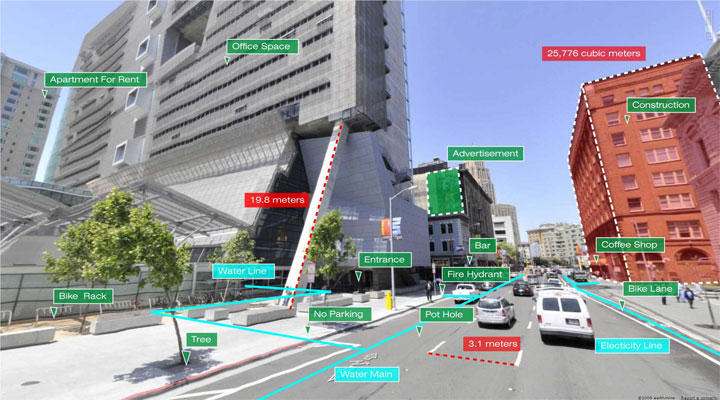Metaio SDK: Augmented Reality Has Become Fuller

For the past 10 years, Metaio GmbH has been developing and improving technologies for augmented reality (PC) for PCs and mobile devices. One of the results of these titanic efforts was the Metaio SDK , a set of tools for embedding DR elements in applications and programs optimized with the support and assistance of Intel under its platforms. The set, by the way, is completely free ! We invite you to take a closer look at this product and see how it works.
So, using Metaio tools, complex and resource-intensive functions of computer vision, such as, for example, three-dimensional tracking of real objects, run smoothly and effortlessly on Intel mobile platforms. This means, above all, that applications using DR technologies will work accurately and stably. Implemented support for many wearable gadgets, improved visualization and processing speed of objects. By the way, Metaio SDK is the only SDK in the mobile segment that provides reliable markerless tracking of three-dimensional objects of the real world, as well as two-dimensional objects. The latest version of the Metaio SDK also supports tracking along contours, allowing users to track the geometry of real objects, which largely solves the problem of irregularity of light.
To date, more than 60 thousand developers using the company's products have been registered on the Metaio portal.
Metaio SDK underlies many mobile applications that use DR, such as the IKEA product catalog for 2012/13, McDonalds McMission, and many others. Consider as an example how the DR is used in the Audi eKurzinfo application. The modern car is extremely saturated with various functions, and it is far from easy to understand how to control them. Audi eKurzinfo allows you to get instant help on the units and controls of the car Audi; just hold the camera to the object of interest to you, and the application will issue a certificate about it. The operation of the system is shown in this small video.
')
The most advanced browser, DR, junaio, also uses the Metaio SDK as a basis.
Key features of the new version of Metaio SDK 5.0:
- Available for Android, iOS and PC platforms; supports 2D, 3D, ID and SLAM tracking;
- Supports wearable gadgets Google Glass, Epson Moverio BT-100 and Vuzix M-100;
- Supports 3D marker-free tracking based on CAD data (contour tracking);
- In 2014, the functionality of tracking by persons will be added;
- Improved rendering quality through programmable shaders;
- Built-in powerful 3D engine, equipped with multi-threaded tracking and rendering pipelines;
- Support for complex 3D models (more than 32 thousand polygons);
- Simple management of 3D content and its debugging (BoundingBox, Normals, Wireframe).
Here is a small training example showing the capabilities of the Metaio SDK. This and other sections of the textbook can be found on the Metaio website .
Let's see how to arrange the various tracking data to get its own augmented reality.
By default, we will use markerless configuration. To get started, download our 3D model.
mMetaioMan = metaioSDK.createGeometry(metaioManModel); Now add onTouch handlers for the buttons. For example, for the button of the picture marker, the Android handler would be
public void onPictureButtonClick(View v) { trackingConfigFile = AssetsManager.getAssetPath("Assets3/TrackingData_PictureMarker.xml"); boolean result = metaioSDK.setTrackingConfiguration(trackingConfigFile); } For iOS, we implemented the UISegmentedControl element, so the code will look a bit different. In AREL (Augmented Reality Experience Language) we will use the jQuery .buttonset () function to create buttons in the HTML code and then attach JavaScript click handlers to it.
As we can see, simply by executing the setTrackingConfiguration (trackingConfigurationFile) method, we get a new tracking configuration.
Note that our configuration for the marker image does not contain a single marker; To be sure that the model includes both pictures from the test task, we need to implement the following functionality by rewriting the onDrawFrame () method in the case of Android, drawFrame () for iOS and defining the tracking handler for AREL.
@Override public void onDrawFrame() { super.onDrawFrame(); if (metaioSDK != null) { // get all detected poses/targets TrackingValuesVector poses = metaioSDK.getTrackingValues(); //if we have detected one, attach our metaio man to this coordinate system Id if (poses.size() != 0) mMetaioMan.setCoordinateSystemID(poses.get(0).getCoordinateSystemID()); } } With the first call, we will get all the detected targets and then, if the target is detected, we will relate our model to the coordinate system of the target. At AREL, we missed the first step because we received a callback with a tracking event.
And finally, a fun video from IKEA about augmented home reality.
Source: https://habr.com/ru/post/198716/
All Articles